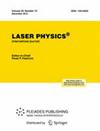镍钛钒智能合金系统高效微钻孔激光参数相互作用的研究
IF 1.1
4区 物理与天体物理
Q4 OPTICS
引用次数: 0
摘要
镍钛形状记忆合金(SMA)因其实用性和机械性能而成为当前研究的热门材料。在不同温度下,镍钛合金会从奥氏体转变为马氏体。为了恢复镍钛 SMA 的高温记忆,需要添加钒(V)作为合金元素。对于镍钛基 SMA,光纤激光是生物植入物、致动器和飞机发动机零件的最佳加工程序之一。本研究采用 Box-Behnken 设计,对激光功率、喷嘴距离、切割速度和频率进行了实验,研究了光纤激光微钻孔 Ni50Ti48V2 SM 合金的材料去除率和孔锥角。通过提高功率(P)、频率(F)和切割速度(CS),Ni50Ti48V2 合金的材料去除率(MRR)提高了 75.79%。当切割速度、激光功率和频率降低时,孔锥角(HTA)下降了 75.33%。降低切割速度和激光功率可增加微孔的圆度并降低 HTA。表面形貌检查发现,钻孔表面有碎屑和熔融材料。氮气流导致材料在 Ni50Ti48V2 合金的入口和出口表面扩散,从而改变了表面粗糙度。氮气流动对表面粗糙度、HTA 和圆度的影响参数较高。材料的 DSC 和 XRD 测试证实了其适用于生物医学微孔生产。本文章由计算机程序翻译,如有差异,请以英文原文为准。
Investigations on the interaction of laser parameters for efficient microdrilling of NiTiV smart alloy system
Ni–Ti shape memory alloys (SMAs) are popular in current research due to their usefulness and mechanical properties. At different temperatures, Ni–Ti alloys transition from austenite to martensite. To restore high-temperature memory in nickel-titanium SMAs, vanadium (V) is added as an alloying element. For Ni–Ti-based SMAs, the fiber laser is one of the best machining procedures for bio-implants, actuators, and aircraft engine parts. Using a Box–Behnken design to experiment with laser power, nozzle distance, cutting speed, and frequency, this study examines fiber laser micro-drilled Ni50Ti48V2 SM alloy material removal and hole taper angle. By increasing power (P), frequency (F), and cutting speed (CS), Ni50Ti48V2 alloy material removal rate (MRR) increased by 75.79%. The hole taper angle (HTA) dropped 75.33% when cutting speed, laser power and frequency decreased. Lowering cutting speed and laser power increases micro-hole circularity and reduces HTA. Upon surface topographical inspection, debris and molten materials were found on the drilled surface. The flow of nitrogen gas caused materials to diffuse on the Ni50Ti48V2 alloy’s entry and exit surfaces, changing surface roughness. High parameters influence surface roughness, HTA, and circularity due to nitrogen gas flow. The material’s DSC and XRD tests confirmed its suitability for biomedical microhole production.
求助全文
通过发布文献求助,成功后即可免费获取论文全文。
去求助
来源期刊

Laser Physics
物理-光学
CiteScore
2.60
自引率
8.30%
发文量
127
审稿时长
2.2 months
期刊介绍:
Laser Physics offers a comprehensive view of theoretical and experimental laser research and applications. Articles cover every aspect of modern laser physics and quantum electronics, emphasizing physical effects in various media (solid, gaseous, liquid) leading to the generation of laser radiation; peculiarities of propagation of laser radiation; problems involving impact of laser radiation on various substances and the emerging physical effects, including coherent ones; the applied use of lasers and laser spectroscopy; the processing and storage of information; and more.
The full list of subject areas covered is as follows:
-physics of lasers-
fibre optics and fibre lasers-
quantum optics and quantum information science-
ultrafast optics and strong-field physics-
nonlinear optics-
physics of cold trapped atoms-
laser methods in chemistry, biology, medicine and ecology-
laser spectroscopy-
novel laser materials and lasers-
optics of nanomaterials-
interaction of laser radiation with matter-
laser interaction with solids-
photonics
 求助内容:
求助内容: 应助结果提醒方式:
应助结果提醒方式:


